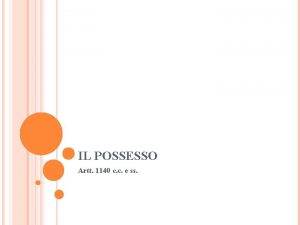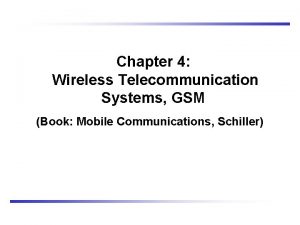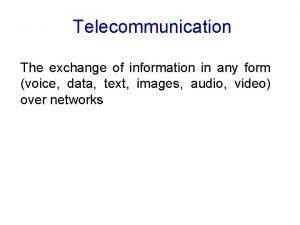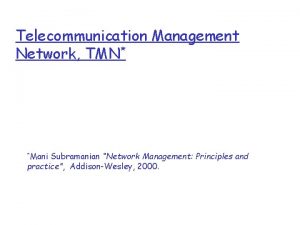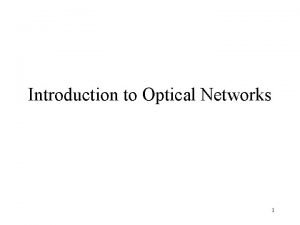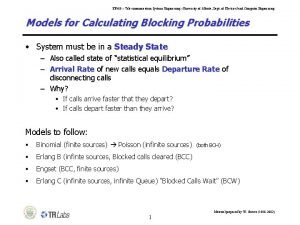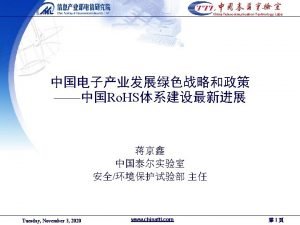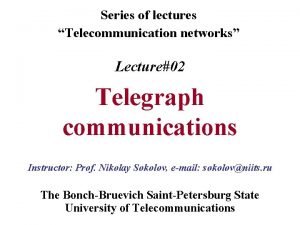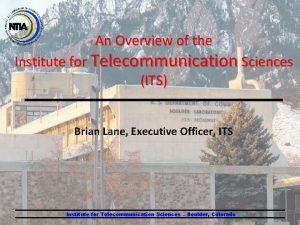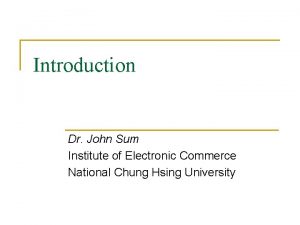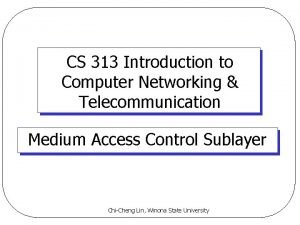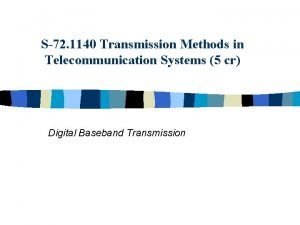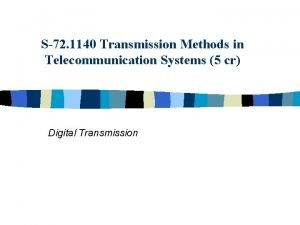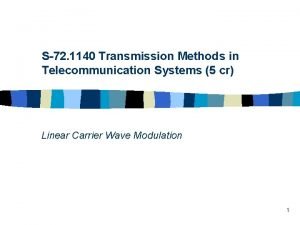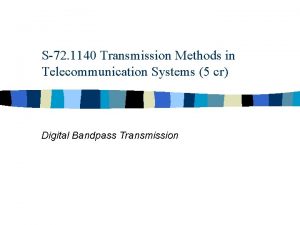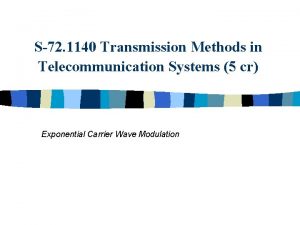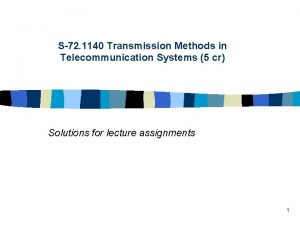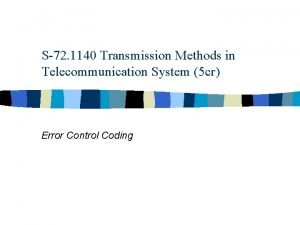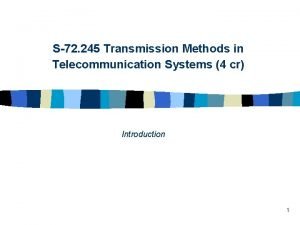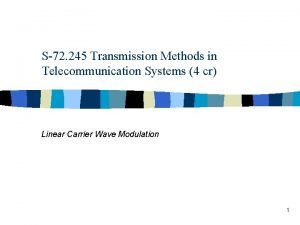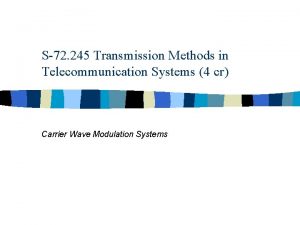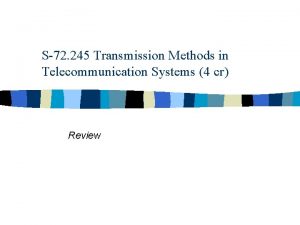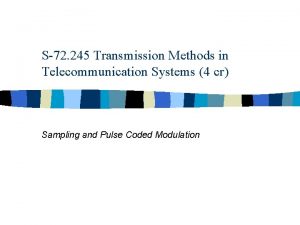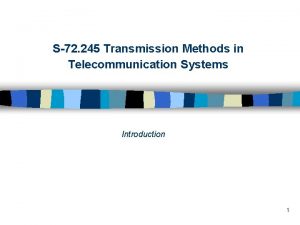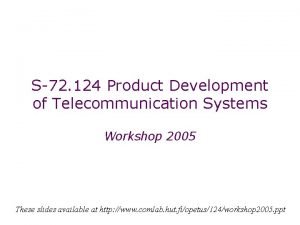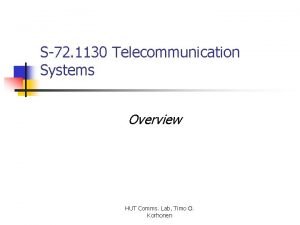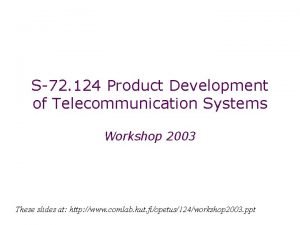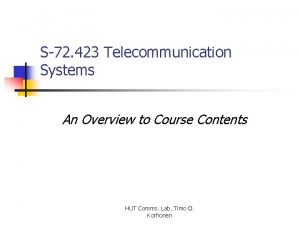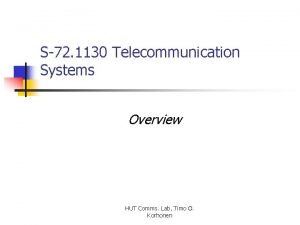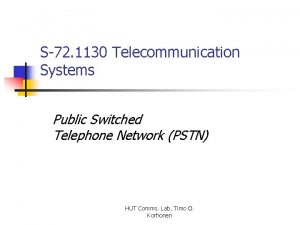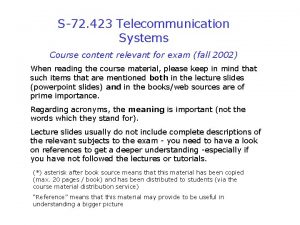S72 1140 Transmission Methods in Telecommunication Systems 5











































- Slides: 43

S-72. 1140 Transmission Methods in Telecommunication Systems (5 cr) Exponential Carrier Wave Modulation

Exponential modulation: Frequency (FM) and phase (PM) modulation n n 2 FM and PM waveforms Instantaneous frequency and phase Spectral properties – narrow band • arbitrary modulating waveform • tone modulation - phasor diagram – wideband tone modulation – Transmission BW Generating FM - signals – de-tuned tank circuit – narrow band mixer modulator – indirect modulators Helsinki University of Technology, Communications Laboratory, Timo O. Korhonen

Contents (cont. ) n n n 3 Detecting FM/PM – FM-AM conversion followed by envelope detector – Phase-shift discriminator – Zero-crossing detection (tutorials) – PLL-detector (tutorials) Effect of additive interference on FM and PM – analytical expressions and phasor diagrams – implications for demodulator design FM preemphases and deemphases filters Helsinki University of Technology, Communications Laboratory, Timo O. Korhonen

Phase modulation (PM) n Carrier Wave (CW) signal: n In exponential modulation the modulation is “in the exponent” or “in the angle” n Note that in exponential modulation superposition does not apply: n In phase modulation (PM) carrier phase is linearly proportional to the modulation x(t): n Angular phasor has the instantaneous frequency (phasor rate) 4 Helsinki University of Technology, Communications Laboratory, Timo O. Korhonen

Instantaneous frequency Constant frequency carrier: Angle modulated carrier n n Angular frequency w (rate) is the derivative of the phase (the same way as the velocity v(t) is the derivative of distance s(t)) For continuously changing frequency instantaneous frequency is defined by differential changes: Compare to linear motion: 5 Helsinki University of Technology, Communications Laboratory, Timo O. Korhonen

6 Helsinki University of Technology, Communications Laboratory, Timo O. Korhonen

rad/s 2 7 Helsinki University of Technology, Communications Laboratory, Timo O. Korhonen

Frequency modulation (FM) n In frequency modulation carrier’s instantaneous frequency is linearly proportional to modulation: n Hence the FM waveform can be written as integrate n Therefore for FM and for PM 8 Helsinki University of Technology, Communications Laboratory, Timo O. Korhonen

AM, FM and PM waveforms Instantaneous frequency directly proportional to modulation waveform constant frequency follows derivative of the modulation waveform 9 Helsinki University of Technology, Communications Laboratory, Timo O. Korhonen

Assignment (i) Briefly summarize what is the main difference between FM and PM ? (ii) How would you generate FM by using a PM modulator? 10 Helsinki University of Technology, Communications Laboratory, Timo O. Korhonen

Assignment (i) Briefly summarize what is the main difference between FM and PM ? (ii) How would you generate FM by using a PM modulator? Solution (i) In PM instantaneous phase is directly proportional to modulating signal amplitude, in FM instantaneous frequency is directly proportional to modulating signal amplitude. (ii) One need to integrate the modulating signal before applying it to the PM modulator 11 Helsinki University of Technology, Communications Laboratory, Timo O. Korhonen

Narrowband FM and PM (small modulation index, arbitrary modulation waveform) n The CW presentation: The quadrature CW presentation: n Narrow band (small angle) condition: n Hence the Fourier transform of XC(t) is n 12 Helsinki University of Technology, Communications Laboratory, Timo O. Korhonen

Narrow band FM and PM spectra n Remember the instantaneous phase in CW presentation: n The small angle assumption produces compact spectral presentation both for FM and AM: What does it mean to set this component to zero? 13 Helsinki University of Technology, Communications Laboratory, Timo O. Korhonen

Example n 14 Assume: Helsinki University of Technology, Communications Laboratory, Timo O. Korhonen

Example 15 Helsinki University of Technology, Communications Laboratory, Timo O. Korhonen

Tone modulation with PM and FM: modulation index b n Remember the FM and PM waveforms: n Assume tone modulation n Then 16 Helsinki University of Technology, Communications Laboratory, Timo O. Korhonen

FM and PM with tone modulation and arbitrary modulation index n Time domain expression for FM and PM: n Remember: n Therefore: 17 Helsinki University of Technology, Communications Laboratory, Timo O. Korhonen Jn is the first kind, order n Bessel function

Wideband FM and PM spectra n 18 After simplifications we can write: Helsinki University of Technology, Communications Laboratory, Timo O. Korhonen

Determination of transmission bandwidth n n n 19 The goal is to determine the number of significant sidebands Thus consider again how Bessel functions behave as the function of b, e. g. we consider Significant sidebands: Minimum bandwidth includes 2 sidebands (why? ): Generally: Helsinki University of Technology, Communications Laboratory, Timo O. Korhonen

Assignment 20 Helsinki University of Technology, Communications Laboratory, Timo O. Korhonen

Assignment Solution M(b) is determined from the condition |Jn(b)| > e, therefore the curve on the previous page can be obtained for instance by fixing a value for b and then adjusting n until the condition is met. Note: n = 1 equals the case with two sidebands (magnitude spectra the same as for AM) 21 Helsinki University of Technology, Communications Laboratory, Timo O. Korhonen

Transmission bandwidth and deviation D n Tone modulation is extrapolated into arbitrary modulating signal by defining deviation by n Therefore transmission BW is also a function of deviation n For very large D and small D with n that can be combined into 22 Helsinki University of Technology, Communications Laboratory, Timo O. Korhonen

Example: Commercial FM bandwidth n Following commercial FM specifications n High-quality FM radios RF bandwidth is about n Note that under estimates the bandwidth slightly 23 Helsinki University of Technology, Communications Laboratory, Timo O. Korhonen

A practical FM modulator circuit n 24 A tuned circuit oscillator – biased varactor diode capacitance directly proportional to x(t) – other parts: • input transformer • RF-choke • DC-block Helsinki University of Technology, Communications Laboratory, Timo O. Korhonen

Generating FM/PM De-tuned tank circuit n Capacitance of a resonant circuit can be made to be a function of modulation voltage. Resonance frequency De-tuned resonance frequency Capacitance diode n That can be simplified by the series expansion Note that this applies for a relatively small modulation index Remember that the instantaneous frequency is the derivative of the phase 25 Helsinki University of Technology, Communications Laboratory, Timo O. Korhonen

Frequency detection n 27 Methods of frequency detection – FM-AM conversion followed by envelope detector – Phase-shift discriminator – Zero-crossing detection (tutorials) – PLL-detector (tutorials) FM-AM conversion is produced by a transfer function having magnitude distortion, as the time derivative (other possibilities? ): As for example Helsinki University of Technology, Communications Laboratory, Timo O. Korhonen

28 Helsinki University of Technology, Communications Laboratory, Timo O. Korhonen

29 Helsinki University of Technology, Communications Laboratory, Timo O. Korhonen

25 30 Helsinki University of Technology, Communications Laboratory, Timo O. Korhonen

Assignment n 31 Show that from figure above follows: Helsinki University of Technology, Communications Laboratory, Timo O. Korhonen

32 Helsinki University of Technology, Communications Laboratory, Timo O. Korhonen

33 Helsinki University of Technology, Communications Laboratory, Timo O. Korhonen

34 Helsinki University of Technology, Communications Laboratory, Timo O. Korhonen

Assignment Consider the following RC-filter transfer function Inspect the relating group delay and state what is a frequency range of low linear distortion 35 Helsinki University of Technology, Communications Laboratory, Timo O. Korhonen

36 Helsinki University of Technology, Communications Laboratory, Timo O. Korhonen

Frequency range of low linear distortion? 37 Helsinki University of Technology, Communications Laboratory, Timo O. Korhonen

Indirect FM transmitter n Mathematica®-expressions n FM/PM modulator with high linearity and modulation index difficult to realize One can first generate a small modulation index signal that is then applied into a nonlinear circuit n 38 Therefore applying FM/PM wave into non-linearity increases modulation index Helsinki University of Technology, Communications Laboratory, Timo O. Korhonen

Indirect FM transmitter: circuit realization n The frequency multiplier produces n-fold multiplication of instantaneous frequency n Frequency multiplication of tone modulation increases modulation index but the line spacing remains the same 39 Helsinki University of Technology, Communications Laboratory, Timo O. Korhonen

Annex Narrowband tone modulation

Tone modulation with PM and FM: modulation index b n Remember the FM and PM waveforms: n Assume tone modulation n Then 41 Helsinki University of Technology, Communications Laboratory, Timo O. Korhonen

Tone modulation in frequency domain: Phasors and spectra for narrowband case n Remember the quadrature presentation: n For narrowband assume 42 Helsinki University of Technology, Communications Laboratory, Timo O. Korhonen

Narrow band tone modulation: spectra and phasors n 43 Phasors and spectra resemble AM: Helsinki University of Technology, Communications Laboratory, Timo O. Korhonen

Assignment AM NB-FM (i) Discuss the phasor diagrams and explain phasor positions based on analytical expressions (ii) Comment amplitude and phase modulation in both cases 44 Helsinki University of Technology, Communications Laboratory, Timo O. Korhonen
 1140 12
1140 12 Math 1140
Math 1140 Art 1140 cc
Art 1140 cc Bsc and msc in telecom
Bsc and msc in telecom Screw gear system type 1
Screw gear system type 1 What is motion transmission
What is motion transmission Motion transmission systems
Motion transmission systems Wax pattern fabrication
Wax pattern fabrication Telecommunications project management
Telecommunications project management Objectives of telecommunication
Objectives of telecommunication Types of telecommunication networks
Types of telecommunication networks Difference between telecommunication and data communication
Difference between telecommunication and data communication Introduction of telecommunication
Introduction of telecommunication Kyushu telecommunication network co.,inc.
Kyushu telecommunication network co.,inc. Telecommunication
Telecommunication Tmn function block: a) osf b) mf c) wsfe d) nef e) qaf
Tmn function block: a) osf b) mf c) wsfe d) nef e) qaf Swift finance retrievals
Swift finance retrievals In a telecommunications network architecture, a protocol is
In a telecommunications network architecture, a protocol is Telecommunication
Telecommunication Global telecommunication system
Global telecommunication system Gerhard steinke
Gerhard steinke Global telecommunication system
Global telecommunication system Itu world telecommunication indicators database
Itu world telecommunication indicators database Cara kerja jaringan kabel
Cara kerja jaringan kabel China telecommunication technology labs
China telecommunication technology labs Telecommunication
Telecommunication Telecommunication sealing technology
Telecommunication sealing technology Institute for telecommunication sciences
Institute for telecommunication sciences World telecommunication standardization assembly
World telecommunication standardization assembly Txpdr
Txpdr Types of telecommunication
Types of telecommunication Telecommunication
Telecommunication Cablaggio strutturato edificio
Cablaggio strutturato edificio Telecommunication
Telecommunication Shervin taghavi
Shervin taghavi Umos msu ru
Umos msu ru Telecommunication system architecture with diagram
Telecommunication system architecture with diagram Quality control in telecommunication
Quality control in telecommunication Telecommunication sealing technology
Telecommunication sealing technology Telecommunications for dummies
Telecommunications for dummies Telecommunication medium
Telecommunication medium China telecommunication technology labs
China telecommunication technology labs Network management principles and practice
Network management principles and practice Telecommunication system architecture with diagram
Telecommunication system architecture with diagram


